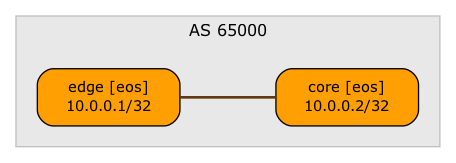netlab: Applying Simple Configuration Changes
For years, netlab has had custom configuration templates that can be used to deploy custom configurations onto lab devices. The custom configuration templates can be Jinja2 templates, and you can create different templates (for the same functionality) for different platforms. However, using that functionality if you need an extra command or two makes approximately as much sense as using a Kubernetes cluster to deploy a BusyBox container.
netlab release 25.09 solves that problem with the files plugin and the inline config functionality.
Imagine you have a very simple BGP lab in which you want the edge router to advertise a default route over an IBGP session1.
defaults.device: eos
provider: clab
module: [ bgp, ospf ]
bgp.as: 65000
nodes:
edge:
core:
links: [ edge-core ]

BGP sessions in the above lab topology
The above topology generates the following BGP configuration on the Edge router:
router bgp 65000
router-id 10.0.0.1
no bgp default ipv4-unicast
bgp advertise-inactive
neighbor 10.0.0.2 remote-as 65000
neighbor 10.0.0.2 update-source Loopback0
neighbor 10.0.0.2 description core
neighbor 10.0.0.2 send-community standard extended large
!
address-family ipv4
neighbor 10.0.0.2 activate
neighbor 10.0.0.2 route-map next-hop-self-ipv4 out
network 10.0.0.1/32
However, we’d need an extra command – neighbor 10.0.0.2 default-originate always.
This is how easy it is to add that command to the Edge router configuration with netlab release 25.09 (complete topology file):
plugin: [ files ]nodes:edge:config.inline: |router bgp 65000neighbor 10.0.0.2 default-originate always
Notes:
- config.inline functionality needs the new files plugin (line 1) that creates custom configuration templates behind the scenes.
- The config.inline attribute (line 5) can be used on individual nodes or node groups (when you need to apply the same command to multiple nodes).
- The config.inline value (multiple lines of configuration commands) should always use the multiline YAML encoding (
|, also known as literal block scalar header).
Behind the Scenes
This is what netlab does with the config.inline attribute:
- The attribute content is stored in a file named _n_node.j2 in the lab directory.
- The node config attribute is converted into a list using the node-specific filename as a custom configuration template. In our lab, the config attribute of the edge node would be set to
[ _n_edge ]. - Once the node has a “regular” config attribute, netlab uses the existing mechanisms to apply the custom configuration commands.
-
You could use the bgp.session.apply functionality of the bgp.session plugin to advertise a default route to all IBGP neighbors, but not to a single neighbor. ↩︎
